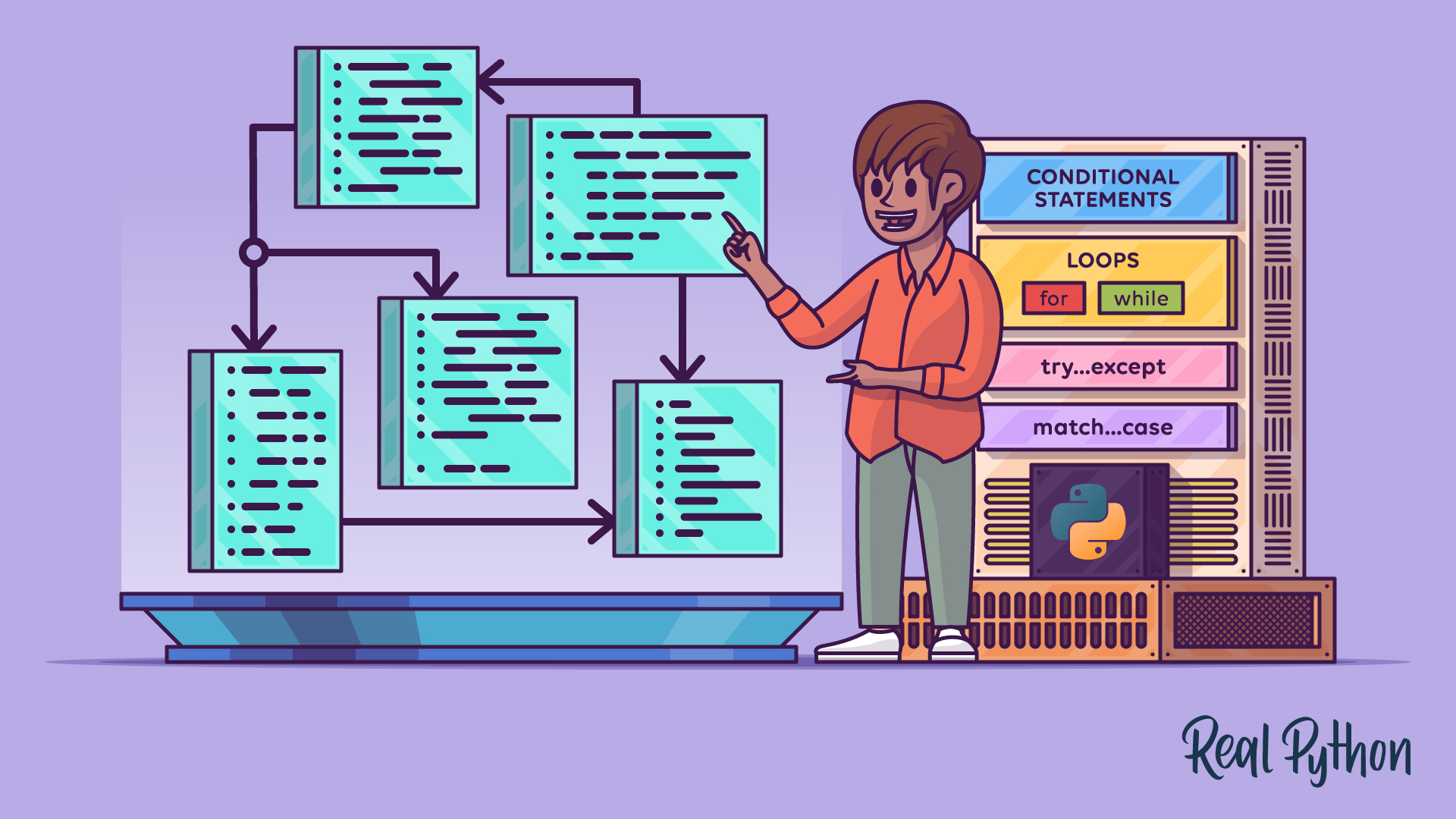Control Flow Structures in Python :
by:
blow post content copied from Real Python
click here to view original post
Python’s control flow structures allow you to dictate the order in which statements execute in your program. You can do this by using structures like conditionals, loops, and others.
Normally, your code executes sequentially. You can modify this behavior using control flow structures that let you make decisions, run specific pieces of code in response to certain conditions, repeat a code block several times, and more.
Knowing about control flow structures is a fundamental skill for you as a Python developer because they’ll allow you to fine-tune how your programs behave.
By the end of this tutorial, you’ll understand that:
- Control flow in Python refers to the order in which code statements are executed or evaluated.
- Common control flow statements in Python include conditionals with the
if,elif,elsekeywords, loops withforandwhile, exception handling withtry…except, and structural pattern matching withmatch…case. - Control flow structures in Python let you make decisions, repeat tasks, and handle exceptions, enhancing the dynamism and robustness of your code.
To dive deeper into Python’s control flow, explore how these constructs allow you to write more dynamic and flexible programs by making decisions and handling repetitive tasks efficiently.
Get Your Code: Click here to download the free sample code that shows you how to use control flow structures in Python.
Take the Quiz: Test your knowledge with our interactive “Control Flow Structures in Python” quiz. You’ll receive a score upon completion to help you track your learning progress:
Interactive Quiz
Control Flow Structures in PythonIn this quiz, you'll test your understanding of Python control flow structures, which include conditionals, loops, exception handling, and structural pattern matching. Strengthening these skills will help you write more dynamic, smart, and robust Python code.
Getting to Know Control Flow in Python
Most programming languages, including Python, execute code sequentially from the top of the source file to the bottom, line by line. This way of running code is entirely logical. It’s like following a series of steps in order. However, what if you’re solving a problem with two or more action paths that depend on the result of evaluating a given condition?
For example, say that you’re building an online store and need to implement a feature that decides whether a customer is eligible for free shipping. You’ve decided that if the order is greater than $150.00, then the customer gets free shipping. In this situation, you have two action paths:
- If the order is less than $150.00, then the customer doesn’t get free shipping.
- If the order is equal to or greater than $150.00, then the customer gets free shipping.
Now, think of a way you could do this with sequential statements. It isn’t an easy task, right? You’d need something that allows you to check the order and decide what course of action to take. That’s exactly what a conditional statement lets you do:
>>> order_total = 215.00
>>> if order_total >= 150:
... print("You got free shipping!")
... else:
... print("The shipping fee is $5.00")
...
You got free shipping!
Note how the code isn’t executed sequentially. Instead, the execution path depends on the condition’s result. Statements and syntax constructs that allow you to alter the normal execution flow as you did in the example above are known as control flow structures.
Note: In programming, the ability of a program to choose between multiple paths of execution based on certain conditions is known as branching.
In programming, the term control flow refers to the order in which individual statements are executed or evaluated within a program. As you already know, the normal flow of execution is sequential. However, you can alter this by using control flow statements, which include conditionals, loops, and several others.
Here’s another example. This time, you need to repeat a task several times. You can do this by duplicating the same line of code as many times as needed:
greeting.py
print("Hello!")
print("Hello!")
print("Hello!")
This code works. However, repeating the same code several times is error-prone and introduces maintainability issues. Additionally, what if you don’t know the number of repetitions beforehand? In this situation, a loop will save you:
>>> for _ in range(3):
... print("Hello!")
...
Hello!
Hello!
Hello!
In this example, you use a for loop to run the code three times. This code is much more elegant, flexible, and less repetitive.
Control flow statements like these let you make decisions, repeat tasks, and handle exceptions, making your code more dynamic and powerful. In short, they let you customize the control flow of your programs. In the rest of this tutorial, you’ll dive into Python’s most commonly used control flow statements.
Using Conditional Statements
You took a quick peek at conditional statements in the previous section. A conditional statement is a syntax construct that lets you execute certain code blocks only when a specific condition is true, while skipping them when the condition is false. It allows your programs to respond to different situations rather than just running sequentially.
Read the full article at https://realpython.com/python-control-flow/ »
[ Improve Your Python With 🐍 Python Tricks 💌 – Get a short & sweet Python Trick delivered to your inbox every couple of days. >> Click here to learn more and see examples ]
May 28, 2025 at 07:30PM
Click here for more details...
=============================
The original post is available in Real Python by
this post has been published as it is through automation. Automation script brings all the top bloggers post under a single umbrella.
The purpose of this blog, Follow the top Salesforce bloggers and collect all blogs in a single place through automation.
============================



Post a Comment